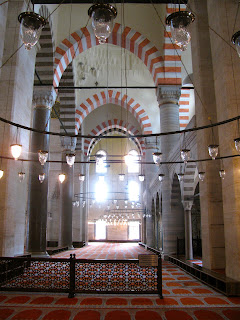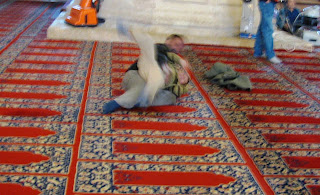Ever wondered what’s inside a mosque? I’m here to take you into some of Turkey’s finest places of Muslim worship and explain the basic features they all contain. First, a few exterior shots.
 |
| The Blue Mosque in Istanbul, photographed from the Bosphorus |
 |
| The tiny Yavasci Sahin Mosque, Istanbul |
Some mosques are grand and stand apart from everything else. Others are nestled among other buildings or built on uneven remnants of land. The Rustem Pasha Mosque in Istanbul is built over the top of several commercial establishments.
 |
| Rustem Pasha Mosque, Istanbul |
Many of the mosques pictured here were built by Turkey’s Michelangelo, Mimar Sinan, who worked for the Ottoman sultans in the 1500s. Believed to be an Armenian Christian, he designed nearly one hundred mosques and hundreds of other important buildings.
Three essential features can be seen in every mosque. The first is the mihrab, a niche carved into the wall of the mosque. It is cut to guide worshippers to face the direction of the Muslim holy city, Mecca. Here are some examples of mihrabs in Istanbul:
 |
| Colorful mihrab in Firuz Aga Mosque, Istanbul |
 |
| Wooden mihrab in mosque, Eskisehir |
 |
| Rustem Pasha mosque mihrab (bottom center) |
The next mosque element is the minbar, the pulpit from which the imam speaks. It is actually a staircase that sits to the mihrab’s right. A door closes the bottom of the staircase, and the top is usually decorated with a turret. Because the turret represents heaven, the imam stands just halfway up the stairs. I find minbars both fanciful and evocative.
 |
| Marble minbar, Selimiye mosque, Edirne |
 |
| Top of minbar, Selimiye Mosque, Edirne |
 |
| Tiled minbar top, Sokkulu Ahmet Pasha Mosque, Istanbul |
The final feature a mosque needs is carpeting. This is because worshippers kneel on the floor to say their prayers. In older times, mosque floors were covered with layers of kilim rugs that overlapped each other and became quite worn. Now special mosque carpeting is used, with designs indicating rows. Mosques arrange worshippers horizontally, in contrast to the more vertical way churches are often set up. This is because Islam seeks to avoid the concept of some worshippers feeling “better” than others.
 |
| New carpeting in 13th century mosque in Divrigi, central Turkey |
 |
| Carpeting matching the arches in one of Istanbul’s Grandest Mosques, the Suleimaniye |
 |
| Yavasca Sahin Mosque, Istanbul |
 |
| A father and young son couldn’t resist a bit of wrestling on the lush carpet in Edirne’s Selimiye mosque |
Those are the three essentials, but mosques often contain other common design features. The first is arches. Doorways and other openings are often expressed by soaring, curved arches.
 |
| Arches and more arches in the Suleimaniye mosque |
 |
| My favorite, Istanbul’s New Mosque (completed in 1663) |
Most mosques also have domed ceilings.
 |
| Dome at Sehzade Mosque, Istanbul, built by Sultan Suleiman I in memory of his son, who died of smallpox at age 21. |
 |
| Dome of Edirne’s Selimiye Mosque |
 |
| Dome, The New Mosque, Istanbul |
Most mosques have windows, and often these are made of stained glass.
 |
| Yavasca Sahin Mosque |
 |
| Blue Mosque, Istanbul |
And most mosques need some form of lighting, even though many are designed to let in a lot of sunlight . The larger mosques in Turkey have huge circular chandeliers (see photos above and below) that hang low over the worship areas.
 |
| Selimiye Mosque, Edirne |
The mosques I’ve showed you thus far are all centuries old. There is an interesting new mosque in Istanbul called the Shakirin Mosque, that was designed by a woman, Zeynep Fadillioglu. Here are some photos of it that I took a couple of weeks ago. What do you think?


























I love the Mosque primer! Beautiful photos and great explanations.
nice pics mom! that’s cool how Islam doesn’t want worshipers to feel better than each other
You’ve got a great selection of photos here, Sue! I especially liked the carpet ones. Great post. And as for the modern mosque at the end, it is quite near where I live and I think it’s great. She did a v good job of updating the image.